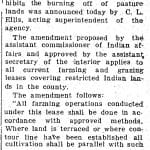Changes Made in Osage Indian Grazing Leases
September 4, 1936
Osage County News
Microfilm Roll: MN00311
Denied the Indians the legal right to lease any of their land. However, the Indians could permit white persons to graze cattle provided that the cattlemen obtained the consent of both the Indians and their agent and paid a rent set by the agent with the approval of the Commissioner of Indian Affairs, (Burrill, 528).This caused several problems for American Indians; the Osages in particular. Many white ranchers would herd their cattle through the lands of Oklahoma and Kansas to reach the railroads. In doing so, ranchers would allow their cattle to graze on Indian land. Although the Indian department’s regulations stated that the rancher had to obtain the permission of an Indian prior to allowing his cattle to graze on their land, often times this did not happen. If the issue was presented to the government, whites would often win the case because of their status of citizenship. However, in 1882, due to a large increase in the cattle population, which led to a boom in market prices, the secretary of the Department of the Interior, Henry M. Teller, was forced to call on the War Department for help in “stop[ping] the incursion and remov[ing] cattle that had already been brought in,” (Burrill, 528) The War Department refused to provide assistance in a situation that needed military enforcement and instead suggested that Teller “allow cattlemen to graze their animals so long as they paid a proper fee to the Indians.” Henceforth, American Indians were allowed to lease their lands. Within a year, however, problems began to arise from the situation. The major issue being that ranchers began enclosing their sections of rented land causing Teller to recant his support for the Indians’ land leasing rights. In 1883, Teller passed another policy, which later came to be known as the “absurd policy,” once again denying American Indians the right to lease land, but stating “that if the Indian lessors were satisfied, the government would not attempt to enforce the no-lease regulation,” (Burrill, 529). Morgan M. Guzman “Changes Made in Osage Indian Grazing Leases.” Osage County News. September 4, 1936, p. 1. Microfilm roll number MN00311. Sequoyah National Research Center, Little Rock, Arkansas.
Further Reading
Burrill, Robert M. “The Establishment of Ranching on the Osage Indian Reservation.” Geographical Review 62, no. 4 (1972): 524-543. “Osage Nation Museum Acquires Map Dating Back to 1900.” Osage Nation Museum. http://osagenews.org/en/article/2018/04/15/osage-nation-museum-acquires-map-dating-back-1900/ Date accessed April 17, 2018.Source File(s)
Related Stories
- Discussion of Government Control of the American Indian by Congressmen
- Indian Bureau Official Here to See Osages
- Osage and Quapaw Get Their Freedom by Sells’ Order
Related Topics
View more stories in

